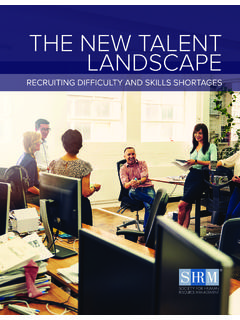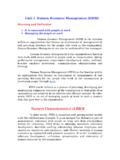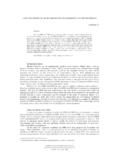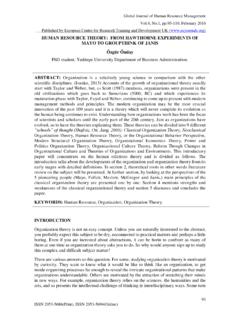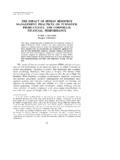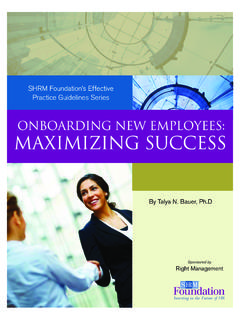Transcription of Human Resource Management Practices in …
1 Human Resource Management Practices in selected Ethiopian Private Companies: A Study to Increase Employee Productivity in Ethiopia by Dirk J. van Wasbeek ISBN: 1-58112-244-6. Boca Raton, Florida USA 2004. Human Resource Management Practices in selected Ethiopian Private Companies: A Study to Increase Employee Productivity in Ethiopia Copyright 2004 Dirk J. van Wasbeek All rights reserved. Boca Raton, Florida USA 2004. ISBN: 1-58112-244-6. Robert Kennedy College Del mont Switzerland Human Resource Management Practices IN.
2 selected ETHIOPIAN PRIVATE COMPANIES.. A STUDY TO INCREASE EMPLOYEE PRODUCTIVITY. IN ETHIOPIA. by Dirk J. van Wasbeek A Dissertation Submitted to Robert Kennedy College in Partial Fulfillment of the Requirements for the Degree of Doctor of Business Administration (DBA). July 2004. Copyright 2004 by Dirk J. van Wasbeek All rights reserved ii Abstract Human Resource Management Practices in selected Ethiopian Private Companies . A Study to Increase Employee Productivity in Ethiopia This dissertation examines how Human resources are managed at selected Ethiopian private companies, how Ethiopian Human Resource Management practice is evolving and how it can be improved.
3 The examination is qualitative and exploratory, since no comparative research on Human Resource Management has yet been conducted at Ethiopian profit or non-profit organizations. An understanding of Ethiopian Human Resource Management practice makes it possible to improve Ethiopian Human Resource Management practice, and thus to increase employee productivity. The study took place at four manufacturing and four service companies in Addis Ababa, all representative of their sector. The research claim is that Ethiopian Human Resource Management Practices differ from Human Resource Management Practices in the West, due to differences in cultural factors, economic systems, political systems, and legal and industrial relations.
4 For this reason, Ethiopia's culture, politics, economy and legal and industrial relations have been analyzed. The main finding of this study is that the importance of Human Resource Management is not uniformly understood at all the case-study companies. Although the multinational companies based in Ethiopia see their Human resources as the companies' most important asset, as Human capital, the local companies generally do not. The fact that respondents claim that Ethiopia has limited experience in industrialization might explain why Human Resource Management in Ethiopia is rudimentary and still has a long way to go.
5 With this dissertation the researcher wants to contribute to improving Ethiopian Human Resource Management practice. Moreover, this dissertation may be used as a framework for similar research in other sectors or for more specific in-depth research. This dissertation may also serve as a knowledge base for company managers, business consultants, academics and government officials of countries with a national culture similar to Ethiopia's (for example Kenya, Tanzania and Zambia), countries undergoing (or which have undergone) a recent transition to a free market economy, and countries facing similar macro-economic developments.
6 Iii To Julia Sarah, Justine and Nathalie iv Dissertation Committee Prof. David Y. Costa, Dean of the Graduate School, at Robert Kennedy College. Dr. Roy Damary, Head of Business Studies, Director of Doctoral Programme, at Robert Kennedy College. Mr. David Duffill, Professor of Corporate Finance, at Robert Kennedy College. v Acknowledgements Many people have contributed to the completion of this dissertation. However, some people more than others. I would like to express special gratitude to my dissertation advisor Dr.
7 Roy Damary. The following dissertation could not have been completed without his patience, direction and instruction. I appreciate his lively engagement in my academic and professional progress, and his experience in academic writing. Next, I wish to thank my local field advisor Dr. Meheret Ayenew who provided insight and instructions which have substantially improved the research and the dissertation, and many discussions that provided me with perspectives to write this work. I also would like to thank my wife, Julia, who provided personal support and understanding all along the way.
8 Furthermore, she edited, with Roy, the major part of the dissertation. Thanks go to Dr. Gail Davey for proofreading the dissertation. Gail has a doctorate in Epidemiology and is professor at the Addis Ababa University. She has several publications to her name. Likewise, I wish to express my indebtedness to my respondents for their cooperation and support while completing my work. I am greatly indebted to the gatekeepers in the case-study companies. Without their understanding and support the research could not have been completed.
9 Vi List of Illustrations Tables Page Primary uses of performance evaluations 37. Adaptive work 52. The five dimensions of national culture in several countries 80. Culture and international competition: competitive advantages of different cultural profiles 85. Population structure in 2000 103. Education statistics 104. Main economic indicators, 2001 114. Origins of Gross Domestic Product (GDP), 1999/2000 114. Gross Domestic Product (GDP) and inflation 119. Profiles of the case-study companies 149.
10 Gender composition of respondents at manufacturing and service companies 155. Respondents' level of education at manufacturing and service companies 156. Respondents' age at manufacturing and service companies 157. Data on previous employers of respondents at manufacturing and service companies - number of employers (including current employer) 158. Respondents' needs and values according to Maslow at manufacturing and service companies 164. Respondents' most liked jobs 180. Respondents' characteristics of the most liked jobs 180.










